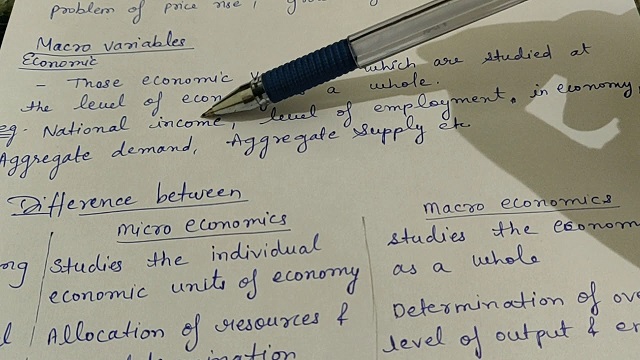What is a macroeconomic variable?
A macroeconomic variable reflects the behavior of a phenomenon in the economy on a large scale.
Some Important points
- Macroeconomic variables reflect large-scale economic phenomena.
- They are also known as aggregate variables.
- They are formed from the sum of microeconomic variables.
A macroeconomic variable, as its name suggests, is an economic variable related to macroeconomics. In other words, it is a characteristic or quality that represents an economic phenomenon at a general level.
Macroeconomic Variable: Simple Explanation
Sometimes these variables are also called aggregate variables. This is because macroeconomics studies the evolution of a set of individuals. Therefore, a macroeconomic variable is the sum of many microeconomic variables.
For example, to calculate the Gross Domestic Product (GDP) , which is a macroeconomic variable, we need data on all individual producers. By adding up the output of all individuals in a region or country, we get the GDP. In this case, microeconomic variables (the output of each economic agent) are added together to form a macroeconomic variable.
Another example is inflation. If we consider the price increase of each product in each store in each city, we obtain inflation. This figure is an estimate, since inflation results from the aggregation of many microeconomic variables.
What is a macroeconomic variable used for?
A macroeconomic variable is used to analyse a part of the economic environment. Thus, if we want to know how the economic interaction of goods from a country with the outside is evolving, we could analyse the trade balance.
The fundamental idea of a macroeconomic variable is to reflect, normally in numerical form, part of the aggregate economic reality. Its study is essential to know what part of the economic cycle we are in or to understand which economic policies could be more effective.
For example, although some countries have done so, raising taxes in an economic crisis is not usually advisable. Why? Because economic agents are going through a bad time and need to have more disposable income to cope with the situation. Measuring economic activity through macroeconomic variables allows us to measure these types of details.
Main macroeconomic variables
The main macroeconomic variables are:
- Gross domestic product (GDP).
- Inflation.
- Unemployment.
- Balance of payments.
- Private debt.
- Public debt.
- Public deficit.
These variables are, without a doubt, the most important, followed and popular. They constitute the macroeconomic variables of main interest. However, there are obviously many more, such as:
- Industrial Production Index (IPI)
- Labor costs
- Private debt
- Public debt
- Interest rates
- International Investment Position (IIP)
- Trade balance
- Risk premium
The indicators mentioned above refer to different sectors. For example, some describe a part of the financial sector, such as interest rates, while others describe a part of the fiscal sector (public debt) or the external sector (balance of payments).
Criticism of macroeconomic variables
In the 21st century, most economists work with databases and indicators of all kinds. In the last century, data existed, but access to them was much more difficult.
With the evolution of technology and the Internet, any economist can access any data. The fundamental problem with macroeconomic data is that many are estimates. That is, there are macroeconomic variables that are not directly observable or, even if they were, they are not population data.
This is vitally important to understand, that numbers are not perfect and can sometimes fail.

